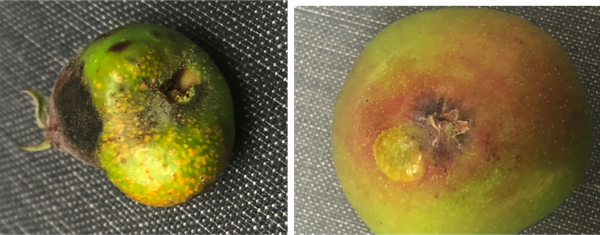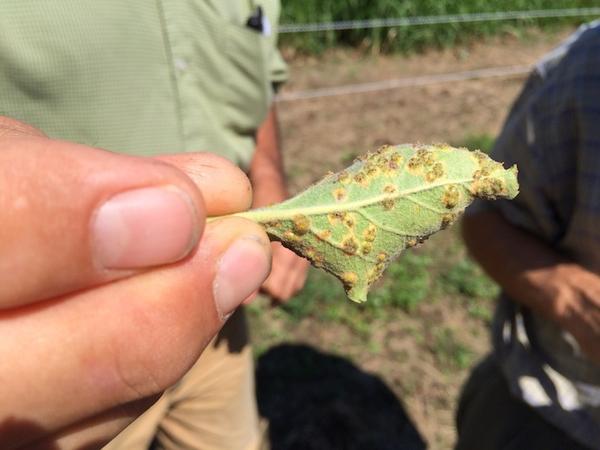Introduction
Cedar apple rust is a disease caused by the fungal pathogen Gymnosporangium juniperi-virginianae, which requires two hosts: apple and red cedars / ornamental junipers to complete its lifecycle. On apple, the pathogen can infect leaves and fruit of susceptible cultivars and may cause premature defoliation if infection is severe. If apple trees are located within 2-5 miles of the alternate host, cedar apple rust should be managed annually from tight cluster until approximately 14 days after petal fall.
Pathogen
Cedar apple rust is caused by the fungal pathogen Gymnosporangium juniperi-virginianae. On apple, quince rust (G. clavipes) and hawthorn rust (G. globosum) are similar in appearance and often mistaken for cedar apple rust.
Symptoms and Signs
Leaves: Infected leaves will have yellow to bright orange round lesions or spots on the upper surface. As infection progresses, fungal tufts or stalks, called aecia, appear on the bottom surface of the leaf directly underneath the lesion.
Fruit: Symptoms of cedar apple rust on fruit initilaly appear as orange colored, slightly raised lesions. As infected fruit mature, lesions on fruit may crack and appear more brown in color. In some cases, fruit stems can become infected and early abscission of fruit may occur. Sporulation on fruit is uncommon for cedar apple rust.
Alternate host: On cedar and juniper, brown dimpled galls (resembling a golf ball) approximately 2 inches in diameter are present during the dormant season. During spring rains, galls will swell as they absorb moisture and produce gelatinous orange colored horns that protrude from dimpled areas on the galls.
Disease Cycle
Gymnosporangium juniperi-virginianae is a heteroecious rust pathogen, meaning that two hosts are required to complete its two-year life cycle. G. juniperi-virginianae overwinters in galls that are induced by the pathogen on susceptible cedars or junipers. During spring rains, the absorption of moisture by galls causes them to swell and produce gelatinous telial horns. Teliospores are produced by the telial horns and subsequently give rise to basidiospores that are immediately discharged and are carried by wind to susceptible apple cultivars. Formation of basidiospores occurs between 46°F and 77°F, however infections to apple leaves and fruit can occur at temperatures as low as 34°F. Infection of leaves by the cedar apple rust pathogen is most favorable when leaves are four to eight days of age, whereas fruit tend to be most susceptible between tight cluster through petal fall. While environmental conditions will influence incubation period, in general symptoms begin to appear 10-14 days following infection.
In mid to late summer, tubular structures called aecia will form on the underside of the leaf, directly oppostite of rust lesions located on the top of the leaf. Aecia produce a new type of rust spore, an aeciospore, that will eventually be released during a period of dry weather and infect nearby cedars or junipers. Aeciospores do not reinfect apple and there is no secondary cycle on the apple host. In the late summer/early fall, aeciospores infect alternate hosts and new galls begin to form during the spring. The galls develop over the next year and fully mature in the second spring following cedar / juniper infection.
Management
Managment of cedar apple rust should focus on infection prevention using a combination of cultural methods and well-timed chemical intervention.
Fungicides
In North Carolina, fungicide applications targeting cedar apple rust should begin around tight cluster and continue on 7 to 14 day intervals through first cover (approximately 10 to 14 days after petal fall). Sterol inhibitor fungicides (S.I.'s FRAC 3) are most efficacious for cedar apple rust management. Since apple scab and cedar apple rust infection periods are similar, applications of S.I.s for apple scab have historically controlled cedar apple rust. However, due to resistance to some S.I. fungicides in apple scab populations and the registration of newer fungicide chemistries for apple scab management, S.I.'s are being applied less frequently for apple scab. These changes in fungicide selection have likely led to increased reports of cedar apple rust throughout Western North Carolina in the past few years. QoI fungicides (FRAC 11) and SDHI fungicides (FRAC 7) have demonstrated limited efficacy against this disease.
| Active Ingredient | Example Formulated Product | Pre-harvest Interval (days) | FRAC Code |
|---|---|---|---|
| myclobutanil | Rally 40WSP | 14 | 3 |
| triflumizole | Procure 480SC | 14 | 3 |
| difenoconazole + cyprodinil | Inspire Super | 14 | 3 + 9 |
| fenbuconazole | Indar 2F | 14 | 3 |
| flutriafol | Rhyme | 14 | 3 |
| mefentrifluconazole | Cevya | 0 | 3 |
| mancozeb | Koverall | 77 (3 lb/A rate) | M3 |
Cultural Control
Removal of all alternate hosts within a four to five mile radius of susceptible apple trees should prevent infection by G. juniperi-virginianae. Given the prevalence of alternate hosts in the landscape and natural environment, however, this approach is not likely sustainable for cedar apple rust management. Removal of alternate hosts within a two mile radius of susceptible apples will disrupt the pathogen life cycle, thus making fungicides more effective.
Host Resistance
Cultivars such as Red Delicious, Gala Supreme, McIntosh, and Liberty are considered resistant to cedar apple rust, whereas Golden Delicious, Rome Beauty, and York Imperial are highly susceptible.
Publication date: June 6, 2018
Recommendations for the use of agricultural chemicals are included in this publication as a convenience to the reader. The use of brand names and any mention or listing of commercial products or services in this publication does not imply endorsement by NC State University or N.C. A&T State University nor discrimination against similar products or services not mentioned. Individuals who use agricultural chemicals are responsible for ensuring that the intended use complies with current regulations and conforms to the product label. Be sure to obtain current information about usage regulations and examine a current product label before applying any chemical. For assistance, contact your local N.C. Cooperative Extension county center.
N.C. Cooperative Extension prohibits discrimination and harassment regardless of age, color, disability, family and marital status, gender identity, national origin, political beliefs, race, religion, sex (including pregnancy), sexual orientation and veteran status.





